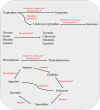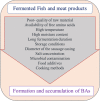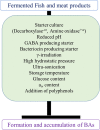A narrative review on biogenic amines in fermented fish and meat products
- PMID: 33897002
- PMCID: PMC8021659
- DOI: 10.1007/s13197-020-04686-x
A narrative review on biogenic amines in fermented fish and meat products
Abstract
Biogenic amines (BAs) are organic nitrogenous compounds, formed mostly by decarboxylation of corresponding amino acids. BAs are responsible for several biological events. However, if the concentration of BAs reached the threshold level, it causes mild to serious health problems in human. The objective of this manuscript was to summarize the prevalence and prevention of Bas formation, detection methods and factors affecting the BAs formation in fermented fish and meat products. Meat sausages are the fermented meat product that contains high BAs. Fish sauces are reported to have high BAs compared to other fish products. Several chemosensors and chromatography methods are available to screen and detect BAs in foods. The prevention measures are vital to avoid toxic outbreaks. The use of starter culture, application of physical factors, control of environmental factors, and use of polyphenols could prevent or diminish the formation of BAs in fermented foods. The literature survey warrants that the development of potent starter with desirable characters, maintenance of hygienic food production and regular monitoring of commercial products are necessary to ensure the quality and safety of fermented fish and meat product.
Keywords: Biogenic amine; Fermentation; Fermented foods; Fish sauces; Sausages; Starter culture.
© Association of Food Scientists & Technologists (India) 2020.
Conflict of interest statement
Conflict of interestThe authors declare that there are no conflicts of interest.
Figures




Similar articles
-
Biogenic amines in dry fermented sausages: a review.Int J Food Microbiol. 2003 Nov 15;88(1):41-54. doi: 10.1016/s0168-1605(03)00080-1. Int J Food Microbiol. 2003. PMID: 14527784 Review.
-
Biogenic amines in foods.Food Sci Biotechnol. 2017 Dec 13;26(6):1463-1474. doi: 10.1007/s10068-017-0239-3. eCollection 2017. Food Sci Biotechnol. 2017. PMID: 30263683 Free PMC article. Review.
-
Detection of Biogenic Amines and Tyramine-Producing Bacteria in Fermented Sausages from Switzerland.J Food Prot. 2020 Sep 1;83(9):1512-1519. doi: 10.4315/JFP-19-468. J Food Prot. 2020. PMID: 32338740
-
Effect of Fermentation with Different Lactic Acid Bacteria Starter Cultures on Biogenic Amine Content and Ripening Patterns in Dry Fermented Sausages.Nutrients. 2018 Oct 13;10(10):1497. doi: 10.3390/nu10101497. Nutrients. 2018. PMID: 30322117 Free PMC article.
-
Control of biogenic amines in fermented sausages: role of starter cultures.Front Microbiol. 2012 May 7;3:169. doi: 10.3389/fmicb.2012.00169. eCollection 2012. Front Microbiol. 2012. PMID: 22586423 Free PMC article.
Cited by
-
Ratio of Histamine-Producing/Non-Histamine-Producing Subgroups of Tetragenococcus halophilus Determines the Histamine Accumulation during Spontaneous Fermentation of Soy Sauce.Appl Environ Microbiol. 2023 Mar 29;89(3):e0188422. doi: 10.1128/aem.01884-22. Epub 2023 Feb 21. Appl Environ Microbiol. 2023. PMID: 36802225 Free PMC article.
-
Influence of different lactic acid bacteria strains and milling process on the solid-state fermented green and red lentils (Lens culinaris L.) properties including gamma-aminobutyric acid formation.Front Nutr. 2023 Apr 13;10:1118710. doi: 10.3389/fnut.2023.1118710. eCollection 2023. Front Nutr. 2023. PMID: 37125035 Free PMC article.
-
Research progress of chilled meat freshness detection based on nanozyme sensing systems.Food Chem X. 2024 Apr 8;22:101364. doi: 10.1016/j.fochx.2024.101364. eCollection 2024 Jun 30. Food Chem X. 2024. PMID: 38623515 Free PMC article. Review.
-
Development of a Food Composition Database for Assessing Nitrate and Nitrite Intake from Animal-based Foods.Mol Nutr Food Res. 2022 Jan;66(1):e2100272. doi: 10.1002/mnfr.202100272. Epub 2021 Dec 3. Mol Nutr Food Res. 2022. PMID: 34792849 Free PMC article.
-
Changes in the Physicochemical Properties of Chia (Salvia hispanica L.) Seeds during Solid-State and Submerged Fermentation and Their Influence on Wheat Bread Quality and Sensory Profile.Foods. 2023 May 23;12(11):2093. doi: 10.3390/foods12112093. Foods. 2023. PMID: 37297338 Free PMC article.
References
-
- 31st Session of the Codex Committee on Fish and Fishery Products. https://ec.europa.eu/food/sites/food/files/safety/docs/codex_ccffp_31_eu.... Cited 19 Feb 2020
-
- Alvarez MA, Moreno-Arribas MV. The problem of biogenic amines in fermented foods and the use of potential biogenic amine-degrading microorganisms as a solution. Trends Food Sci Tech. 2014;39(2):146–155.
-
- Alves SP, Alfaia CM, Škrbić BD, Živančev JR, Fernandes MJ, Bessa RJB, Fraqueza MJ. Screening chemical hazards of dry fermented sausages from distinct origins: biogenic amines, polycyclic aromatic hydrocarbons and heavy elements. J Food Compos Anal. 2017;59:124–131.
-
- Ba HV, Seo HW, Kim JH, Cho SH, Kim YS, Ham JS, et al. The effects of starter culture types on the technological quality, lipid oxidation and biogenic amines in fermented sausages. LWT Food Sci Technol. 2016;74:191–198.
-
- Bargossi E, Gardini F, Gatto V, Montanari C, Torriani S, Tabanelli G. The capability of tyramine production and correlation between phenotypic and genetic characteristics of Enterococcus faecium and Enterococcus faecalis strains. Front Microbiol. 2015;6:1371. doi: 10.3389/fmicb.2015.01371. - DOI - PMC - PubMed
Publication types
LinkOut - more resources
Full Text Sources
